These discoveries have been published in Nature Communications (Q1, SCIE, IF=13.46), one of the world 's leading research journals. The research on the house toad (a poisonous species) is the result of a joint study by the Center for Insects and Parasitology, Duy Tan University, with Prof. Dr. Christophe Dufresnes (Nanjing Forestry University, China) and Assoc. Prof. Dr. Nikolay A. Poyarkov (Moscow State University, Russia) in addition to the consulting support of a number of leading experts from countries including the United States, Russia, France, England, Germany, Pakistan, Portugal, Italy, Canada, Finland, India, China, Slovakia and Thailand.
Groundbreaking Research on the Venomous House Toad on the Silk Road
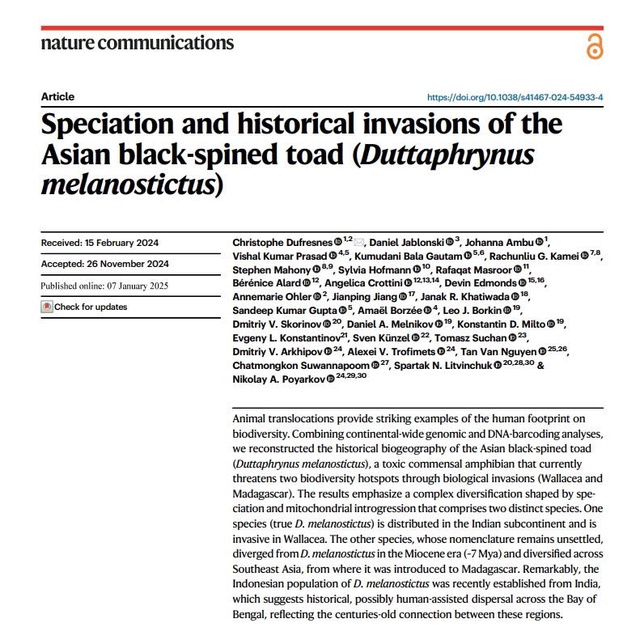
New findings on poisonous house toad published in Nature Communications
The latest discovery of the house toad species Duttaphrynus melanostictus has made a strong impression and has been officially published in Nature Communications - a prestigious multidisciplinary scientific journal, belonging to the Q1 group with an impact factor (IF) of up to 13.46. Nature Communications is a multidisciplinary, open-access, peer-reviewed scientific journal, published by Nature Portfolio since 2010. This is a multidisciplinary journal, covering natural sciences such as physics, chemistry, earth sciences, medicine and biology. The journal has editorial offices located in London, Berlin, New York and Shanghai.
The study focused on the house toad Duttaphrynus melanostictus, a toxic amphibian that poses a major threat to two hotspots of biological invasions, Wallacea and Madagascar. Combining molecular biological analyses across the entire range of the species, it was discovered that: " Duttaphrynus melanostictus, long considered a single species, actually comprises at least two distinct species ."
- One species is endemic to Southeast Asia and has migrated to Madagascar, and
- The remaining species are restricted to the Indian subcontinent and Indonesia but have been included in Wallacea.
This new discovery has contributed to clarifying the role of humans in promoting animal migration and distribution, thereby leaving a clear mark on the global biodiversity map.
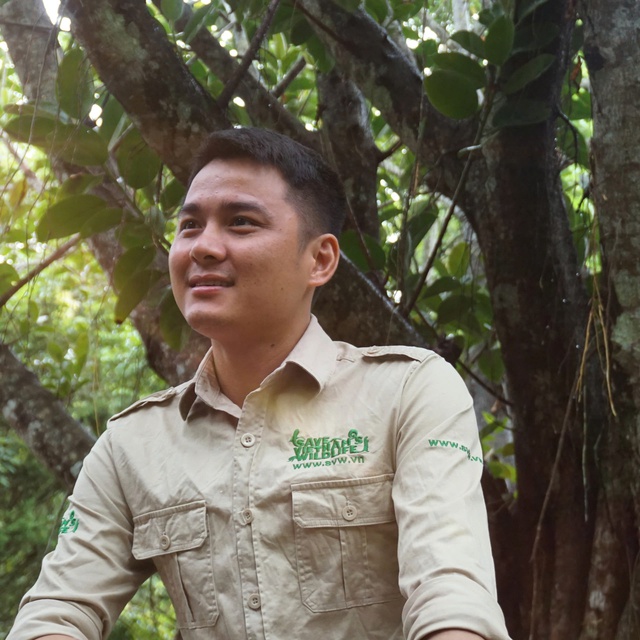
MSc. Nguyen Van Tan (DTU) with many important studies focusing on Amphibians and Reptiles in Vietnam
The House Toad Duttaphrynus melanostictus is confirmed to be extremely dangerous, similar to the Cane Toad (Rhinella marina) - a notorious ecological enemy in the natural world. When stressed, House Toads will secrete toxins that can be fatal to inexperienced predators, including large iconic species such as the Komodo dragon (Varanus komodoensis). This makes the spread of House Toads from Madagascar, Australia, the Indian subcontinent, to Southeast Asia, China and Taiwan a global ecological threat. Therefore, the research of MSc. Nguyen Van Tan and colleagues not only clarifies the biological invasion mechanism but also provides insight into how to manage and conserve wildlife as well as helps people easily recognize this toad species, avoiding unsafe contact leading to burns, swelling or even death when used as food without knowing how to prepare it.
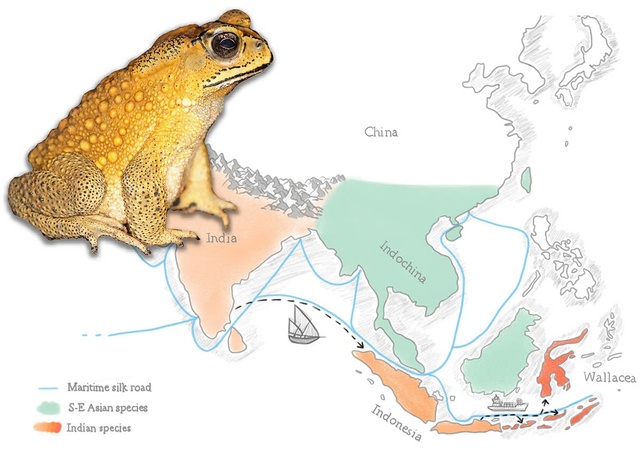
Distribution range of two species hidden under the name Duttaphrynus melanostictus
" With the results of this study, we would like to make important recommendations for scientists and managers to pay special attention to groups of animals at risk of migrating with human movement. Some of these species are not only resilient, potentially invasive and cause serious damage to the native environment, but can also carry uncontrolled pathogens. Typical examples include the golden apple snail, red-eared slider, or even the COVID -19 outbreak believed to have originated from bats carrying the Corona virus, which has caused serious consequences for the environment and global health, " said MSc. Nguyen Van Tan.
Impressive scientific achievements from passion for biodiversity research
MSc. Nguyen Van Tan, since his days as a student of Biology and Chemistry at Tay Bac University, has oriented himself towards scientific research on biodiversity, especially Amphibians and Reptiles. That passion soon bore fruit in 2014, when he was still a 4th year student, he and his excellent research team won the First Prize of the "Young Vietnamese Science Talent" Award with the topic: "Research on the diversity of Amphibians in Sop Cop Nature Reserve, Son La Province".

Genetic relationship analysis of the house toad Duttaphrynus melanostictus reveals at least two species within this complex group.
After graduating, MSc. Tan continued to develop his research career at prestigious scientific agencies and organizations such as the Institute of Ecology and Biological Resources (under the Vietnam Academy of Science and Technology) and the Vietnam Wildlife Conservation Center (Save Vietnam's Wildlife). In 2022, he officially worked at Duy Tan University, becoming a research officer at the Center for Insects and Parasitology.
At Duy Tan University, with the maximum support from the school and colleagues in an open working environment, MSc. Tan continues to work hard on scientific research. In 2024, he and many authors published the book Diversity of Bird Fauna of Lang Sen Wetland Reserve and 21 international articles (including 4 articles in group Q1 and 12 articles in group Q2). These achievements significantly contribute to the treasure trove of knowledge on Amphibians and Reptiles, not only in Vietnam but also in neighboring countries.
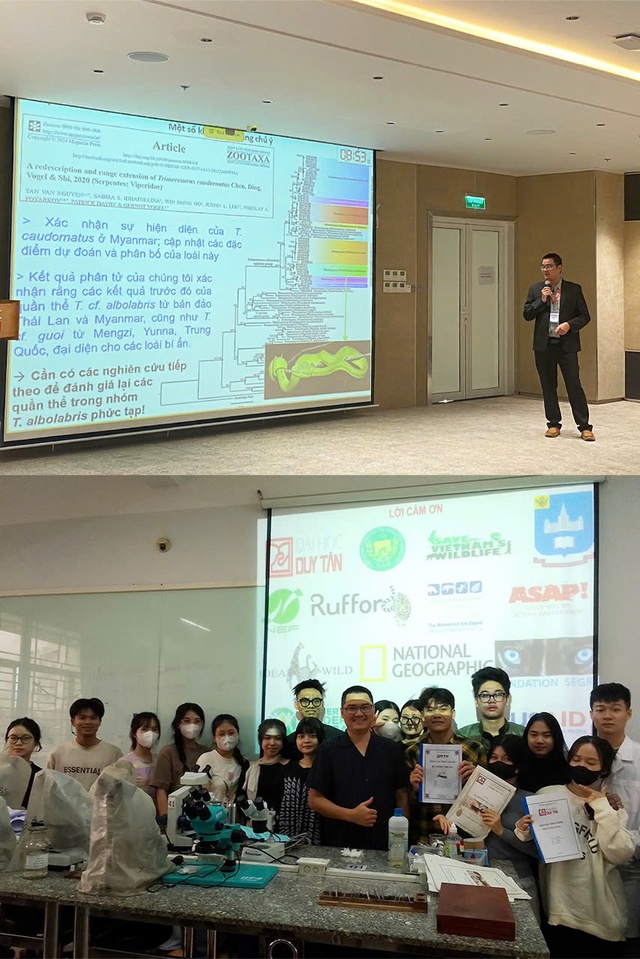
MSc. Nguyen Van Tan shares research on green pit vipers (Trimeresurus) at Duy Tan Medical and Pharmaceutical Conference 2024
To date, MSc. Tan has published more than 65 peer-reviewed articles in prestigious international journals with a Research Gate H-index = 12. He has participated in the description of 1 new lizard genus (Laodracon Brakels), 20 new reptile species and 12 new amphibian species. Notably, his research focuses on biological, molecular classification and conservation of many important species such as Micryletta (Gourd Frog genus), Tylototriton (Toad genus), Trimenesurus (Green Viper genus), Pareas (Slug-eating Snake genus), and Lycodon (Lycodon genus). These works have been published in other prestigious international journals such as: Molecular Phylogenetics & Evolution (Q1, IF=3.58), Zoological Research (Q1, IF=3.64), PeerJ (Q1, IF=5.02) and Vertebrate Zoology (Q1, IF=2.45), in addition to other journals in the Q2 group such as Zootaxa, European Journal of Taxonomy, Biodiversity Data Journal...
MSc. Tan shared: " I am expanding my research direction, focusing more deeply on biological classification, genetic relationships, evolution, ecology and conservation of Amphibians and Reptiles. One of the main focuses is the study of toxicology and venomous snakes in Vietnam as well as neighboring areas. Through this, I hope to raise public awareness, provide accurate scientific knowledge, and contribute to minimizing risks from venomous snake bites. Since June 2021, I have co-founded and directly managed the Snake Identification & First Aid for Snakebites in Vietnam (SIFASV) group, an online community with more than 145,000 active members on Facebook ( https://www.facebook.com/groups/sifasv ). This is a platform for me and my colleagues to share knowledge, support snake identification, provide information on timely and proper first aid for snake bites, contributing to protecting public health ".


![[Photo] Memorial service for former President Tran Duc Luong in Hanoi](https://vphoto.vietnam.vn/thumb/1200x675/vietnam/resource/IMAGE/2025/5/25/c9d24daa63ae4b24b820fd37c633ae81)

![[Photo] Ho Chi Minh City holds funeral for former President Tran Duc Luong](https://vphoto.vietnam.vn/thumb/1200x675/vietnam/resource/IMAGE/2025/5/24/9c1858ebd3d04170b6cef2e6bcb2019e)

![[Photo] The Government Standing Committee works with ministries and branches on the real estate market situation.](https://vphoto.vietnam.vn/thumb/1200x675/vietnam/resource/IMAGE/2025/5/24/e9b5bc2313d14c9499b8c9b83226adba)






















![[Photo] Party and State leaders visit former President Tran Duc Luong](https://vphoto.vietnam.vn/thumb/1200x675/vietnam/resource/IMAGE/2025/5/24/960db9b19102400e8df68d5a6caadcf6)


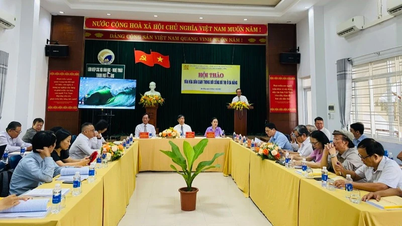
































































Comment (0)